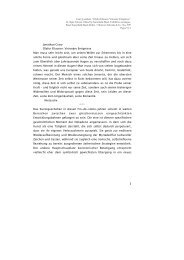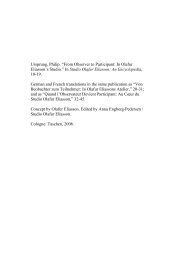Studio Olafur Eliasson
Studio Olafur Eliasson
Studio Olafur Eliasson
Create successful ePaper yourself
Turn your PDF publications into a flip-book with our unique Google optimized e-Paper software.
Writings<br />
The most obvious series of correspondences are between the<br />
continuing series of lamps <strong>Studio</strong> <strong>Olafur</strong> <strong>Eliasson</strong> produces, like those<br />
hanging in “Innen Stadt Außen” (including New Berlin sphere<br />
[2009] and Yellow to purple activity sphere [2009]), and Munari’s<br />
series of mobiles, such as the Useless Machines begun in the<br />
1930s, and his Aconà Biconbì (ca. 1962), a geometric puzzle that<br />
could be composed and recomposed by the owner. 13 But the<br />
importance of design for a deeper understanding of <strong>Eliasson</strong>’s practice<br />
is nowhere more pertinent than when Your blind movement and<br />
Munari’s Projections with Polarized Light (1954) are considered<br />
together. Much more than just a formal affinity—in this sense<br />
<strong>Eliasson</strong>’s Between inside and outside (2008) is closer in configuration<br />
to Projections with Polarized Light—these works reveal the extent<br />
to which both Munari and <strong>Eliasson</strong> have similar goals in mind for<br />
their respective works: stimulating a heightened awareness in the<br />
beholder by rendering him an active coproducer in the work through<br />
the dematerialization of form. 14 While being a goal <strong>Eliasson</strong><br />
shares with many artists of his generation, this is an element rarely<br />
found in contemporary design practice, which tends to be closed<br />
regarding its relationship to the user and so provides them with less<br />
room for maneuver. Unfortunately, the recent interface between<br />
art and design—culminating in the designart trend—has tended to<br />
downplay the participatory dimension of design at the price of<br />
playing up characteristics associated with more traditional forms of<br />
art practice. 15 Just as art was beginning to open up by increasing<br />
the role of the beholder, design practice was reducing it.<br />
It could even be argued that Munari’s projections are a more vital<br />
precedent than the Light and Space artists for <strong>Eliasson</strong>’s installations—besides<br />
Your blind movement, earlier works such as Who is<br />
afraid (2004), Fivefold sphere projection lamp (2004), and Colour<br />
space embracer (2005) point to this. Like Munari, <strong>Eliasson</strong> makes<br />
a point of exposing the mechanism—in the case of Your blind<br />
70<br />
<strong>Studio</strong> <strong>Olafur</strong> <strong>Eliasson</strong><br />
movement, a number of light bulbs and a fog machine—operating<br />
each of his works, whereas the likes of Turrell opt to hide theirs in<br />
an attempt to transport the viewer into the realm of the sublime, a<br />
technique and an effect entirely at odds with <strong>Eliasson</strong>’s installations.<br />
With overtones redolent of Umberto Eco’s notion of the open work,<br />
in a chapter devoted to his Continuous Structures from Design as<br />
Art (1966) Munari offers a lucid account of the importance of placing<br />
the beholder at the center of the work:<br />
We need to give the spectator more room to penetrate into the<br />
work itself, and works which allow this are called “open.” It is a<br />
form of art that adapts itself to the artistic sense of the beholder.<br />
… Today the person who looks at a work of art is more sensitive,<br />
more accustomed to simultaneous and intense stimuli, to brand<br />
new technical and scientific concepts, so he is no longer interested<br />
in a “closed” work of art. Art that is too defined … leaves a man<br />
of today standing isolated and apart. … There is very little actual<br />
participation involved. … But in an open work of art a person<br />
participates much more. 16<br />
The beholder’s participation—what the design world terms “user<br />
interface”—is inherent to a designers’ process. Munari intensified<br />
his investigation into this with his polarized light projections.<br />
Describing them in Design as Art, Munari states, “Polaroid has the<br />
same effect as a glass prism, which … breaks down a ray of white<br />
light into all the colors of the spectrum. … If we take two sheets of<br />
Polaroid and sandwich a piece of Cellophane between them, folded<br />
over two or three times, we shall produce a color.” 17 For the Projections<br />
with Polarized Light, Munari inserted slides between two Polaroid<br />
filters. By rotating the filter fixed before the projector, the polarized<br />
light passed through the materials in the frame and decomposed<br />
into the colors of the spectrum, disrupted as the beholder passed<br />
in front of them. 18<br />
71









